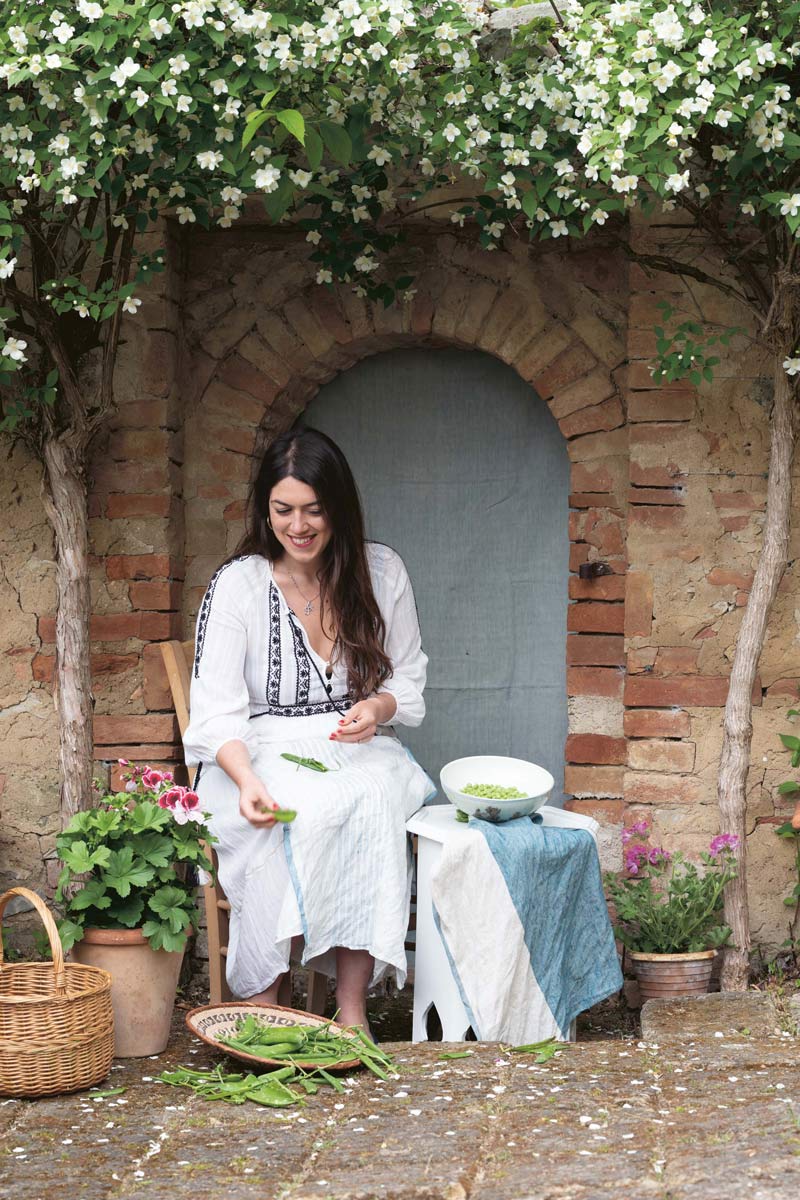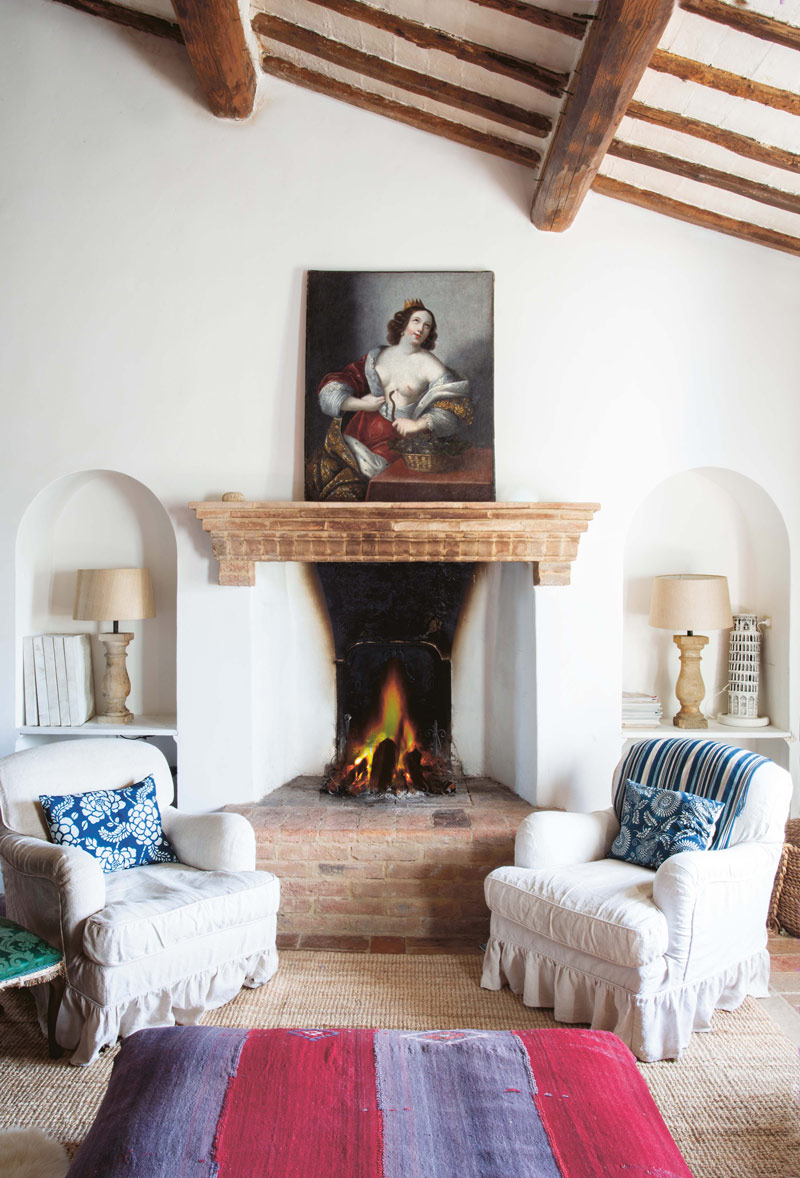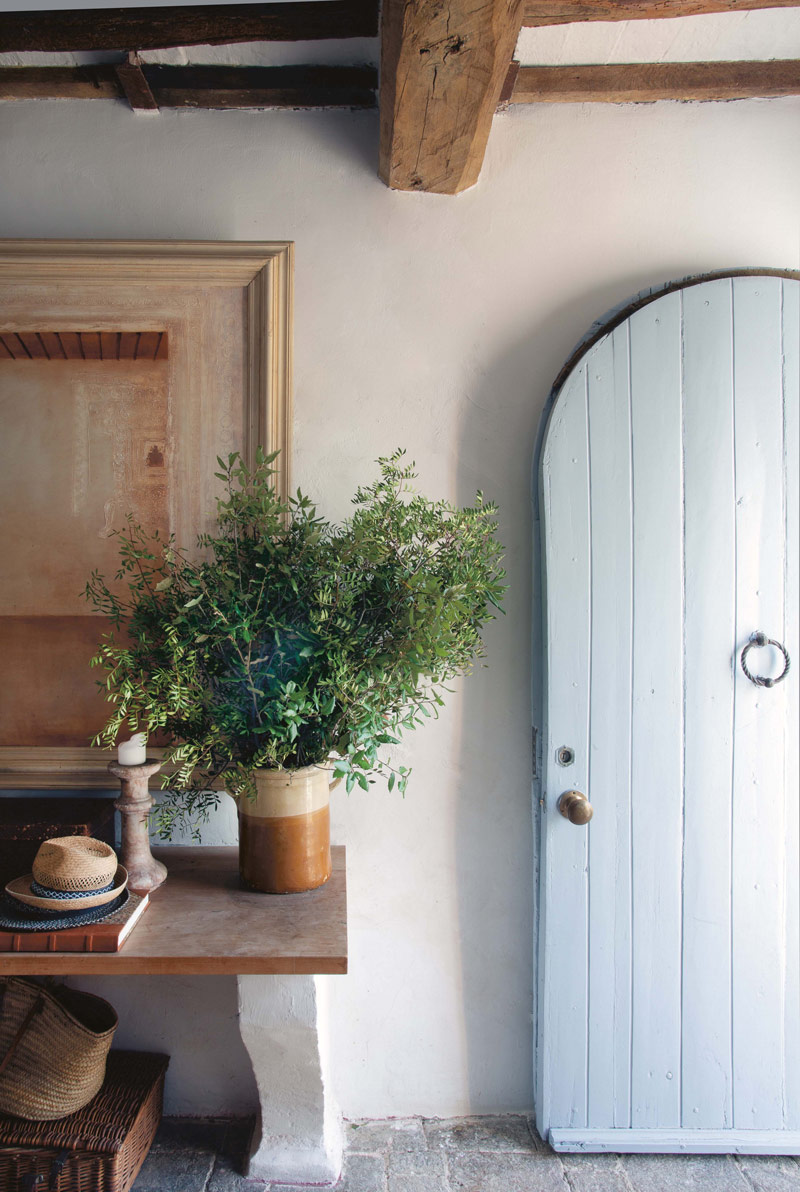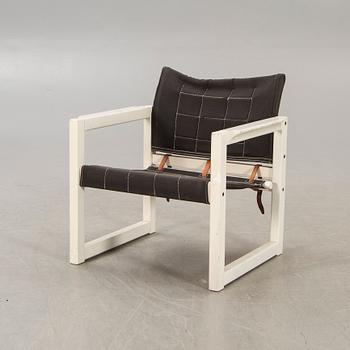Inside Amber Guinness magical abode in Tuscany

Daybeds in the garden at Arniano. © Robyn Lea
Amber Guinness
Photography Robyn Lea & Saghar Satareh
Amber Guinness is a cook, author and journalist living in Florence. She was born in London and brought up in Tuscany. She learned to cook at her mother’s side in the kitchen at Arniano, the farmhouse restored by her parents Jasper and Camilla. In 2014, she co-founded the Arniano Painting School with her friend, the artist William Roper-Curzon. The courses are residential painting holidays designed to breathe life back into the house following her father’s death and are centred around creativity and food, with William teaching guests to oil paint and Amber cooking delicious meals for all.
Amber’s debut cookbook ‘A House Party In Tuscany’ was launched this Spring.

Tell us about your family home Arniano?
Arniano is an isolated farmhouse an hour and a half south of Florence, where we lived full time and where my sister and I went to school until she was ten and I was thirteen. When my parents Jasper and Camilla bought it in 1989, it was derelict and had no electricity or water. They had decided to find a larger house than the one they were living in Greve, a small town in the lush green enclave of Chianti. They looked at dozens of properties before settling on Arniano, which they fell in love with the moment they absorbed the 360-degree views of Montalcino. And once they had opened all the shutters and realized that the rooms spanned the width of the building, allowing light to come in on both sides, they were sold. It is an 18th-century podere where in the past, rural families lived together upstairs, and the animals lived downstairs. The house is long and wide, with vaulted brick ceilings on the ground floor and high ceilings with massive wooden beams upstairs. Today, there are mown lawns, rows of cypresses, olive groves, a herb garden, and several shaded terraces, but back in 1989, the house say in the middle of scrubland, every outhouse tumbling down. My parents undertook the not underwhelming task of knocking down dividing walls, opening up new doorways and installing plumbing to turn Arniano into our much-loved family home and the beautiful house it is today.
How would you describe your design aesthetic?
I’m blessed that my mother, Camilla Guinness, is an interior designer, and I have always been surrounded by beautiful interiors and objects. What she did at Arniano and the nearby Villa Cetinale is very inspiring. She has taught me a love of bold colours and textiles, especially on a crisp white background. For example, in our apartment in Florence, we’ve placed a huge red antique ’suzane’ on a white-washed wall above our sofa, which is clean and white but covered in an array of bold cushions in various fabrics. Mixed thoughtfully and harmoniously with pictures and carpets, this can create a sense of complete comfort and cosiness. I have also very much inherited her love of red and white stripes. I find my mother’s talent for design very inspiring. Watching her work is inspiring as you can see her conjuring up images of what things should look like in her mind’s eye and with such ease. People underestimate what a talent that is.

› © Robyn Lea
”
Hugely, most of my earliest memories from my childhood and adolescence are from growing up at our family home Ariano. Spending all my formative years in Italy meant that food and its rituals are melded for me with family, lovely surroundings, and nature.
Can you tell us about Arniano painting school and how it came into being?
The Arniano Painting School came into being in 2014 over a drink in Notting Hill with my great friend, the painter William Roper-Curzon. I was looking for a way to breathe life back into Arniano, our beloved family home, after my father’s death in 2011. We had moved to the UK six years previously, but my dad was always there, tending to his much-loved garden. I wanted to find a reason to spend more time there and share the beauty of this place that my parents had created. Happily, William was also searching for a new adventure. So, we came up with the idea of hosting residential painting holidays at Arniano, where William would teach painting, and I would cook seasonal Italian food for the guests. Looking back, it seems like a rather mad idea – to bring together a house full of strangers who would share meals and classes for a week. But it took off, and life-long friendships are forged on our courses, which is lovely. Under William’s gentle and informed guidance, our guests find great confidence to carry on painting after they leave us, which is wonderful. We are now planning our first course in the UK this August at Pylewell Park, William’s family home on the Solent in Hampshire. It’s a beautiful house, with Grinling Gibbons wood carving adorning the dining room walls and a copy of Bernini’s Apollo and Daphne in the hall.


› The kitchen at Arniano. © Robyn Lea
How much has your upbringing in Italy impacted your choice of career?
Hugely, most of my earliest memories from my childhood and adolescence are from growing up at our family home Ariano. Spending all my formative years in Italy meant that food and its rituals are melded for me with family, lovely surroundings, and nature. My mum claims to have hung up her skillet now but was and still is a wonderful cook, having a knack for imbuing any dish or dining situation with beauty and glamour, as well as lots of flavours. The food was always Italian, with some English classics thrown in. I remember roast red peppers painstakingly peeled and laid out in alternating canary yellow and ruby red on round plates and finished with perfectly spherical juicy balls of mozzarella placed at their centre. Broad beans would be shelled into beautiful blue or green-speckled Tuscan bowls, accompanied by wheels of fresh pecorino made by our local shepherds. Being surrounded by the incredible produce of Italy and producers of amazing ingredients for so many years made me obsessed with food and how to bring out the best in whatever ingredient you may have to hand.
Who are your favorite artists?
I love etchings. My favourites are by Samuel Palmer, who made dreamy nighttime landscapes in the 19th century, and Jason Hicklin, a contemporary artist who makes incredible dramatic landscapes of the Scottish coast. I also love colour and bold lines, so I love Matisse, Picasso, Gauguin, and David Hockney.
Tell us about an art piece or object that means a lot to you?
I own a painting by my cousin Elliott Puckette, an amazing abstract artist working in New York. Her work looks calligraphic and comprises exquisitely executed fine lines usually etched into gesso with a razor blade. The work I own is on a block of wood which has been washed with a midnight blue gesso and has a bright white line swooping around the surface of the wood. I find it romantic and soothing. It is one of my most treasured possessions.
What are you looking for at auctions?
Interesting and unique pieces. It’s always very exciting to find a surprising or unusual piece of art or furniture - which often only happens at auctions.

› The hall table, adorned with olive branches and other greenery foraged from the woods. © Robyn Lea
What is the secret to being a great host?
Be relaxed. No one has ever had a fun time when the host is visibly stressed. The key to being able to relax when you’re hosting is to prepare everything ahead of time. So chop all your vegetables in peace while listening to music or a podcast when things are quiet, then just shove them in the oven when the guests arrive for aperitivo. Equally, with the aperitivo, fill your ice bucket ahead of time, make sure that there are all the glasses you need, and that there are snacks on the bar before everyone sits down for dinner. That way, you don’t need to get up and down like a jack-in-the-box and can sit and chat with your guests before taking whatever you’re serving out of the oven or putting on the pasta to smother in your pre-made sauce at the last moment.
** Do you have tips for creating the most beautiful table setting?**
I think it depends on the mood you want to create. Sometimes I want the evening to be fun and colourful, so I will choose a tablecloth accordingly – my favourites are from the Milanese designer Lisa Corti; she mixes gorgeous patterns with lovely colour combinations. If I am going all-out, I will pair this with ‘Palio’ plates bought from nearby Siena, which are decorated in the gorgeous colours of the various contrade of Siena, which race in the city’s famous horse race. If I want a meal to feel more serene, a crisp white linen table cloth with foraged greenery as centre pieces works well (I cut branches from the olive tree and put them in small silver cups), and lots of candles. Candles look beautiful at various heights, some tall and some low, giving a sense of movement to your table.
What inspires you?
Amazing food producers who are doing interesting things. Wine growers making natural wines, cheese makers who produce unusual cheeses in beautiful places, caper farmers who can make capers varied and interesting as an ingredient – for instance, on the island of Salina near Sicily, there is a woman who cultivates capers and serves them with pasta, in delicious salads, and also candied on top of ice cream.

› © Robyn Lea
”
The house is long and wide, with vaulted brick ceilings on the ground floor and high ceilings with massive wooden beams upstairs surrounded by mown lawns, rows of cypresses, olive groves, a herb garden, and several shaded terraces

› Spectacular views. © Robyn Lea
What book are you reading at the moment?
Natalia Gibzburg’s Happiness as Such
Your top three favourite spots in Florence?
Trattoria Camillo for lunch
San Ambrogio food market for groceries
The loggia dei Lanzi for sculptors
To Ambers book
To Ambers instagram











































